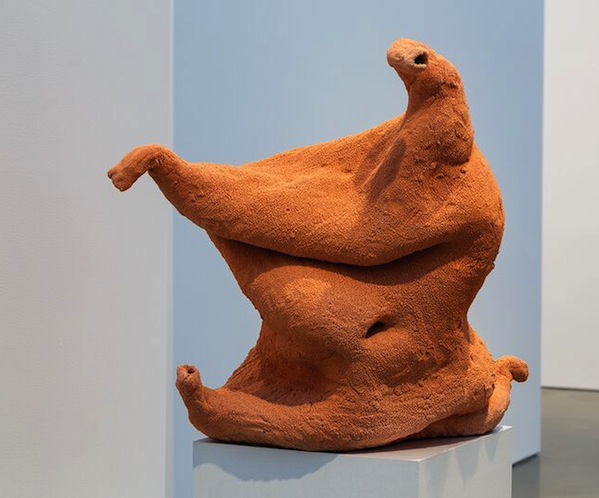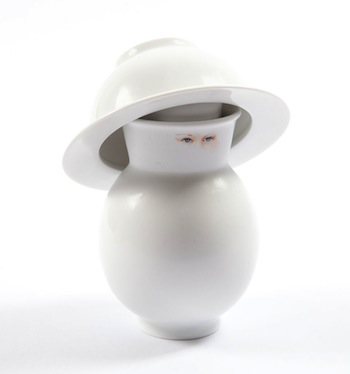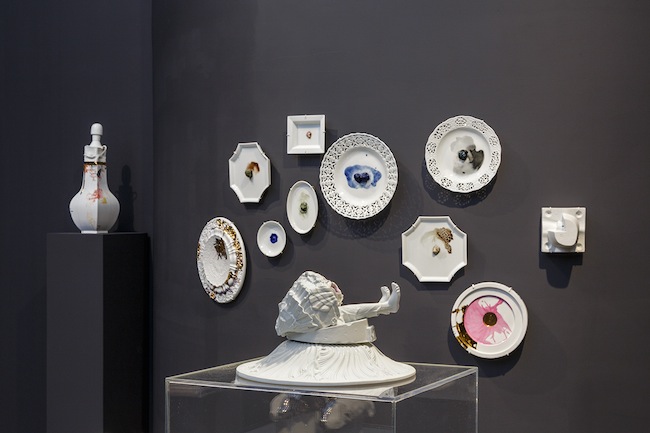Visual Arts Review: Arlene Shechet — Restoring the Wonder of Fine Ceramics
In Arlene Shechet’s mischievous hands, the medium’s power as a shape shifter runs wild.
Arlene Shechet: All at Once, at the Institute of Contemporary Art, Boston, MA through September 7.

Arlene Shechet, “No Noise,” 2013, Glazed ceramic, acrylic paint, and wood. Collection of Treacy and Todd Gaffney. Photo: Courtesy of the ICA/Boston.
By Peter Walsh
The gallery attendants at the Arlene Shechet show at the ICA look nervous. And with good reason. Most of Shechet’s complex, delicate, and fragile ceramic pieces, some of them as large as a small child, are on display without glass cases. Perhaps they had heard about a 2006 incident at Cambridge University’s Fitzwilliam Museum. A visitor tripped on a shoelace, fell down a flight of stairs, and crashed into three large Chinese vases that had been quietly sitting on a window sill off a landing for 40 years. The mishap instantly shattered the vases, collectively worth around $800,000, into some 400 fragments.
The trauma of the Cambridge disaster (the vases were later restored) and the slight feeling of suspense in the ICA galleries this summer are part of the cultural baggage that comes with any exposure to high-level ceramic art. An aura of ravishing achievement, astonishing virtuoso skill, and jaw-dropping market value hover around such displays. Yet utter destruction could strike any second.
High art ceramics have a slightly shady reputation in Western culture. In novels or movies, porcelain collectors are always villains, eccentrics, or fools. Breaking a valuable porcelain object, as does the hapless narrator in Daphne du Maurier’s Rebecca, is a portent of immanent doom. Next to serious art media like painting and sculpture, fine porcelain looks callow and heartless, too beautiful or too grotesque, too delicate, too charming, too precious, and too useless.
The chief joy of Arlene Shechet: All at Once, billed as the artist’s “first museum survey” (though it covers only two decades of a presumably much longer career) is that the sculptor embraces all of this mottled background story and gives us back one better. A playful creator in many media, Shechet “began to work with clay because I wanted a material with a history but also a plasticity that would allow me to make anything.” She has called clay “three-dimensional drawing material” and she lives up to her boast.

Arlene Shechet, “Sexy Baby Eyes,” 2012, Glazed Meissen porcelain. Photo: Courtesy of the artist and Sikkema Jenkins & Co.
Shechet absorbs media and historical influences like an amoeba. Her ceramics explain up front why clay is an ancient metaphor for the creation of life. In her hands, the medium’s power as a shape shifter runs wild. Her over-the-top shapes and dull to brilliant colors exploit the tensile strength of ceramic and its agile ability to become something it is not. Shechet’s surfaces can mimic rust, the incrustations of sea creatures, human flesh. Her works deftly evoke Buddhist figurines, translucent coelenterates, or a whimsical, tentacled alien.
The ICA installation is loosely organized into chapters, each formed by Shechet’s experiences, influences, and collaborations. An introductory gallery is filled with her impressions of the huge 9th-century Borobudur monument in Central Java, the world’s largest Buddhist temple, a mountain-like construction decorated with 2672 carved stone reliefs and 504 Buddha statues. In the ICA exhibition, seated Buddhas, similar in shape to those of Borobudur, and Buddha heads, constructed of industrial molding plaster and painted in acrylics, are set on a series of platforms that vaguely suggest the rising terraces of the temple.
Their lumpy, blurred castings and spatters of paint, which further obscure the forms, suggest Buddhas that have weathered for centuries in a tropical jungle. An invitation to work at the Dieu Donné Papermill in New York led Shechet to create a series of blueprints on handmade abacá paper, displayed nearby, which explore variations on the mandala-like geometry of Borobudur.
In the next gallery, a series of delicate, symmetrical, slightly milky shapes of blown crystal, made in the early 2000s, suggest floating jelly fish or other translucent sea creatures They share space with a ceramic installation, Building (2003), which was created in collaboration with students in Seattle. Formed in bisque (unglazed) porcelain, cut and reassembled in tall stacks, and colored in splashes of cobalt blue by an elaborate molding process, the graceful baluster forms suggest classic Chinese blue-and-white ware deconstructed. The shapes, which seem like symbols of containers more than vases, are utterly functionless. “The vessel,” Shechet says in a nearby label, “is a kind of sacred domestic architecture.”
In the succeeding spaces, hand formed clay sculptures suggest coiling worms, alien creatures, or clouds. Glazes mimic polished metal or wooden boxes. Many pieces seem to be quietly alive. The signature work of the show, No Noise (2013), featured in the ICA’s advertising, reaches out towards its viewers with curious tentacles.
Perhaps the most surprising section of the show is in a smaller, side gallery, dedicated to works created during Shechet’s residency at the famous Meissen factory near Dresden. In that location in 1710 production began of the first true hard European porcelain. The factory has produced costly showpieces, made with astonishing skill, ever since. Here, however, the work is in cases and it seems somehow appropriate.

“Arlene Shechet: All at Once” installation view. Photo: John Kennard, Courtesy of the ICA/Boston.
In Shechet’s variations on established Meissen traditions, graceful shapes in pure, perfectly white porcelain abruptly stop, are sliced off, or move away in unexpected directions. Gilding and fine, hand-painted decoration suddenly goes out of control, spilling across surfaces as if flung against it. Tiny, delicately formed feet stick out from outlandish places.
There is a marvelous play between the aristocratic delicacy of the Meissen-inspired pieces and Shechet’s uninhibited, absurdist sense of humor. She both nods to Meissen’s amusing rococo fantasies and pokes them in the eye. Besides more than 55 pieces of her own work, the display includes historic (and, no doubt, exceedingly valuable) 18th-century figurines and wares, shaped by some of the most celebrated Meissen modelers of the factory’s Golden Age. It is hard to tell where the antique work stops and the contemporary begins, suggesting there might be a greater affinity between Shechet and the original Meissen craftsmen than you might think.
The ICA’s clean, logical installation gives space to work that might otherwise have been confusing or downright threatening. The wall labels are just long enough to be read and absorbed by the casual visitor. The lack of glass cases in most of the show was a bold and aesthetically useful decision: these works were obviously meant to be seen without the distancing effects of reflections and glazed barriers. The whole display is, in fact, one of those rare places where advanced, contemporary work can be easily viewed, appreciated, and immediately and thoroughly enjoyed by anyone, with a minimum of curatorial intervention.
Before mass production and the snobbery of fine art, fine ceramics were a source of magic, mystery, and delight. Shechet restores this wonder.
Peter Walsh has worked for the Harvard Art Museums, the Museum of Fine Arts, Boston, Wellesley College, The Metropolitan Museum of Art, Dartmouth College, and the Boston Athenaeum, among other institutions. His reviews and articles on the visual arts have appeared in numerous publications and he has lectured widely in the United States and Europe. He has an international reputation as a scholar of museum studies and the history and theory of media.
Tagged: Arlene Shechet, Arlene Shechet: All at Once, ceramics, fine art, ICA/Boston
